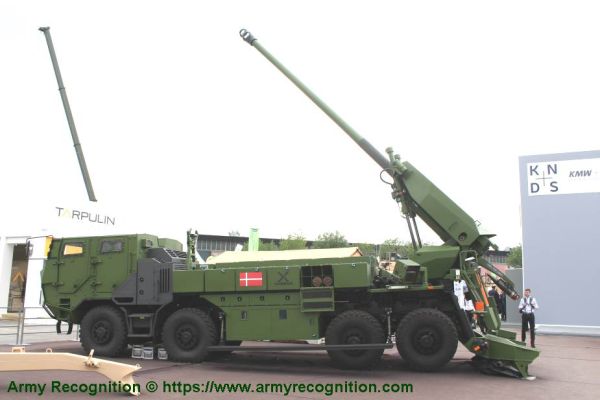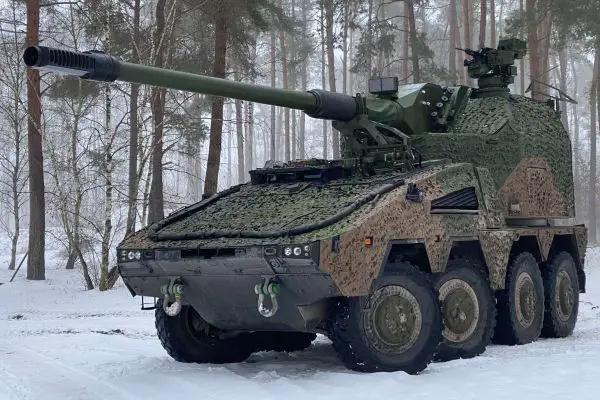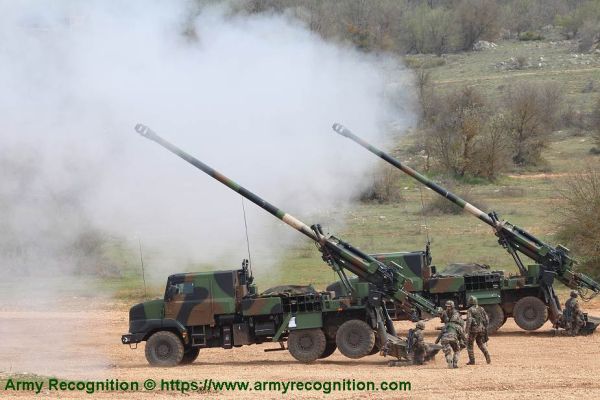Self-propelled howitzers.
CAESAR Mk 2 NG.

The CAESAR Mk 2 (CAmion Équipé d'un Système d'ARtillerie - Trucked Equipped with Artillery System) is an upgraded version of the French CAESAR 6x6 self-propelled howitzer, developed by Nexter Systems now KNDS. The CAESAR Mk 2 maintains the same 155mm/52-caliber cannon as its predecessor but introduces several key improvements, such as enhanced crew protection and a more powerful engine. Designed for rapid deployment, this highly mobile artillery system emphasizes shoot-and-scoot tactics, allowing for swift in-and-out action in hostile environments.
Country users: Belgium, France, Lithuania
Description
The CAESAR Mk 2 was developed by Nexter Systems now KNDS as part of the French Army’s artillery modernization program, responding to evolving battlefield needs such as increased crew protection, more advanced electronics, and improved operational resilience. The development of the CAESAR MkII was officially launched in December 2021, as announced by French Prime Minister Jean Castex in Roanne, marking a major step forward in French artillery technology. This updated version features reinforced armor protection for the crew cabin, a digital fire control system, and enhanced battlefield connectivity. Officially unveiled in 2022, the CAESAR Mk 2 builds on the success of the original CAESAR while incorporating improvements that address feedback from operational deployments. The Mk 2 entered service with the French Army in 2024, demonstrating its capability in delivering long-range precision fire and providing fire support to fast-moving units.
Belgium signed a contract to acquire 28 CAESAR Mk 2 155mm howitzers as part of their artillery modernization efforts in 2022. The Belgian Army's decision to invest in the CAESAR MkII underscores the system's reliability and combat-proven performance in both international and domestic military operations. The contract between Belgium and Nexter Systems highlights Belgium’s commitment to enhancing its artillery capabilities with cutting-edge technologies. Other nations, such as Denmark and Saudi Arabia, have also expressed interest in acquiring the CAESAR Mk 2 due to its adaptability to various operational environments and its proven track record in combat situations, particularly in Ukraine and the Middle East.
During a meeting in Paris that was held on December 29, 2022, the Lithuanian Minister of National Defence Arvydas Anušauskas and Minister of the Armed Forces of France Sebastien Lecornu concluded the bilateral agreement for joining the CAESAR NG (New Generation) development program also including the acquisition of 18 CAESAR Mark II NG 155mm wheeled self-propelled howitzers for the Lithuanian armed forces.
In January 2024, the DGA (Direction générale de l'armement - French Army Procurement Agency)) has announced an order for 109 CAESAR 6x6 Mk 2, a new version that is currently under development. This order is part of the French 2024-2030 defense programming law and is aimed at gradually replacing the AUF1 self-propelled howitzer, which is nearing the end of its operational service, and eventually phasing out the earlier CAESAR 6x6 MkI in the French Army. This significant order will elevate French artillery capabilities to an unprecedented level since the introduction of the CAESAR 6x6 system in 2008. Additionally, the order includes logistical support for the CAESAR MkII during its first two years of service, ensuring a smooth integration into the French military.
The CAESAR Mk 2's primary missions include providing long-range precision artillery fire, counter-battery fire, and fire support for rapid-deployment and combined arms operations. It excels in shoot-and-scoot tactics, allowing it to fire on enemy positions and quickly relocate before counter-battery fire can be directed against it.
CAESAR Mk 2 NG variants:
CAESAR 6x6 (Original Version): This is the baseline version mounted on a 6x6 truck chassis and armed with a 155mm/52-caliber howitzer. It is widely used by the French Army and other international forces, balancing mobility and firepower. The truck can carry 18 rounds and offers a range of up to 40 km with standard ammunition, extendable to over 50 km with rocket-assisted projectiles.
- CAESAR 8x8: This version, mounted on an 8x8 truck chassis, provides greater stability and payload capacity. It is designed to carry more rounds (up to 30) and offers better protection and mobility, especially over rough terrain. Countries like Denmark and the Czech Republic have opted for this more robust version, which is also equipped with additional armor for better crew protection.
Technical Data
-
Armament
The CAESAR Mk 2 is armed with a 155mm/52-caliber howitzer, similar to its predecessor, and carries 18 rounds onboard. It is capable of sustaining rapid fire over extended periods due to its highly efficient reloading system. The howitzer has a maximum hydraulic elevation of +66° and a traverse range of 17° to both the left and right. In case of a hydraulic failure, the cannon is equipped with manual controls, ensuring continued operability.
Additionally, the CAESAR Mk 2 can engage ground targets in an indirect fire mode, with an elevation range from -3° to +10° and a traverse of 21° left and 27° right. The system uses an automatic hydraulic laying system for quick and accurate targeting. Charges and projectiles are manually placed on a stretcher before being automatically loaded into the howitzer for firing, streamlining the process for higher efficiency during operations.
The CAESAR Mk 2 offers fuel resupply and ammunition handling systems directly from the ground, enhancing its ability to stay in combat without needing to return to base. The enhanced logistics support ensures the Mk 2 remains combat-effective even in extended operations. It is a highly versatile artillery system compatible with a wide range of 155mm NATO-standard ammunition, which enhances its role on the modern battlefield. Among the different types of ammunition it can fire are the Extended Range Full Bore (ERFB) shells, which are high-explosive rounds capable of reaching up to 40 km in range when fired from the CAESAR Mk II's 52-caliber cannon. Another type is base-bleed ammunition, designed to reduce drag and extend range by emitting gas from the base, allowing the shell to reach distances of 40-42 km.In terms of longer-range firepower, the CAESAR Mk II can also use Rocket-Assisted Projectiles (RAP), which are equipped with small rocket motors that increase their range to over 50 km. For precision strikes, it can fire Excalibur GPS-guided shells, which use GPS for high-accuracy targeting, reducing collateral damage, and can engage targets up to 46 km away. The system is also compatible with Very Long-range Artillery Projectiles (VLAP), which combine base-bleed and rocket-assist technology to reach targets as far as 55 km.
The CAESAR Mk II can also fire smoke and illumination rounds, which are used for obscuring enemy positions or illuminating the battlefield during nighttime operations. A particularly advanced capability of the CAESAR Mk II is its ability to fire the KATANA smart artillery shell, a guided 155mm round developed by Nexter. The KATANA uses a hybrid guidance system combining GNSS and inertial navigation, and offers precision within 10 meters, making it ideal for long-range precision strikes. The shell has a range of 30 km for early models, with future versions expected to extend to 60 km, further enhancing the CAESAR Mk II's ability to engage targets accurately in complex environments.
-
Design and protection
The general layout of the CAESAR Mk 2 closely resembles that of its predecessor, with the crew cab positioned at the front and the 155mm artillery system mounted at the rear of the vehicle. The crew cab is a distinct upgrade from the earlier model, featuring two doors on each side for easier access. Ammunition storage boxes and charges are mounted on either side of the truck chassis, providing easy access to the crew during operations.
One of the key improvements in the Mk 2 is the reinforced, ballistic, and mine-protected cabin, which significantly enhances the survivability of the crew. This protection system is designed to withstand the rigors of modern combat, including defense against small arms fire, shell splinters, and improvised explosive devices (IEDs). The vehicle's survivability is further boosted by its rapid deployment and repositioning capabilities, allowing it to quickly fire and relocate to avoid enemy counter-battery fire, a critical feature in today’s dynamic battlefields
When the CAESAR Mk 2 is in a firing position, a large hydraulic spade is lowered at the rear of the truck to stabilize the vehicle. This spade, combined with the rear wheels being lifted off the ground, absorbs the recoil from the 155mm gun, ensuring accurate and stable firing performance. This design allows for sustained artillery fire without damaging the chassis or reducing accuracy due to recoil.
The howitzer has a combat weight of 26.7 tons and can accommodate a nominal crew of 5, although it is designed to operate with a minimum crew of 3, providing operational flexibility. This feature allows for extended deployment times and makes the system adaptable to various mission profiles, whether in high-intensity conflict or more constrained logistical situations.
-
Mobility
The CAESAR Mk 2 is typically based on a Renault Sherpa 10 military truck chassis. However, it can be adapted to other chassis configurations based on customer requirements, providing flexibility for different operational needs. The vehicle is powered by a 460 hp diesel engine, a significant upgrade from the 215 hp engine of the original model. This increase in power grants the CAESAR Mk 2 enhanced tactical mobility, allowing it to maneuver more effectively in difficult terrain and avoid enemy retaliatory actions, a key feature in modern "shoot-and-scoot" artillery tactics.
The chassis upgrade also increases the vehicle's payload capacity, enabling it to carry more ammunition and providing improved protection for the crew. These enhancements allow the CAESAR Mk 2 to sustain longer engagements while maintaining combat effectiveness in extended operations. The system's maximum range remains 600 km on a full tank, and its optimized suspension and tire pressure adjustment systems allow it to traverse challenging landscapes. Additionally, it features a traverse angle of +/- 300 mil to 1174 mil (63°), giving it wide target coverage without the need for constant repositioning.
-
Combat Equipment
The CAESAR Mk II is equipped with several advanced combat and onboard systems that enhance its performance in both firepower and operational efficiency. It features a sophisticated digital fire control system, allowing rapid target acquisition and highly accurate ballistic computations. The system includes a muzzle velocity radar that continuously adjusts fire based on real-time projectile data, ensuring precise targeting during engagements.
The howitzer also incorporates modern communication and electronic warfare systems, including the latest version of fire control software, and is prepared to accommodate the CONTACT radio system for secure communications. Additionally, the Thales BARAGE jammer can be integrated, providing high-power jamming capabilities against improvised explosive devices (IEDs) and other electronic threats, enhancing survivability in hostile environments.
Specifications
-
Armament
One 155mm/52-caliber howitzer
-
Country users
Belgium, France, Lithuania
-
Designer Country
France
-
Combat Equipment
- Digital Fire Control System for automatic aiming and ballistic computation
- Muzzle Velocity Radar for real-time projectile data
- CONTACT Radio for secure communications
- Thales BARAGE Jammer for electronic warfare capabilities (optional)
- Automatic Hydraulic Laying System for precision targeting -
Crew
Standard crew of 5 (minimum crew of 3)
-
Armor
STANAG Level 2 protection (ballistic and mine protection) Resistant to small arms fire, artillery splinters, and IEDs (Improvised Explosive Devices)
-
Weight Truck
26,700 kg
-
Speed Truck
80 to 100 km/h road speed
-
Range Truck
600 km
-
Dimensions
Length: 10.0 m; Width: 2.55 m; Height: 3.26 m












































